Incremental Reading: Reading "Quantum computing for the very curious" in SuperMemo (I)
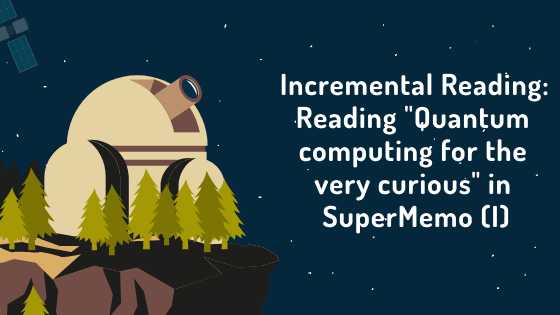
Why this particular Quantum computing for the very curious article?
The authors (Andy Matuschak and Michael Nielsen) say that this medium is superior, for one, the element of spaced repetition is embedded into the article. I agree, and in my opinion, this is what SuperMemo’s Incremental Reading (IR) entails. In this article I’ll use this exact article to demonstrate how I do IR with it, so you may see how IR is similar or different from this new learning medium.
Even if you aren’t curious about “quantum computing”, I still recommend that you give it a quick read (It’ll probably still take some time since it’s a book-sized article). Embedded into the content about quantum computing lies the authors' ideas about how to tackle the problem “why books don’t work”. There are many good sessions on spaced repetition, self-testing, and memory. The session “A medium which makes memory a choice” is particularly illuminating. If you wish you may just skip those quantum computing parts. That’s what I did: I skimmed through those parts but read slowly about the characteristics and description of this new medium.
Introduction on this new mnemonic medium
I don’t want to sound too enthusiastic but this is, more or less, how IR works. IR is also “a mnemonic medium which integrates spaced-repetition testing” (and more).
Reading “Quantum computing for the very curious” in SuperMemo
This is how I read this long article with IR in SuperMemo. Everybody has a different workflow and this is meant only to be exemplary. Your Mileage May Vary.
1. Importing
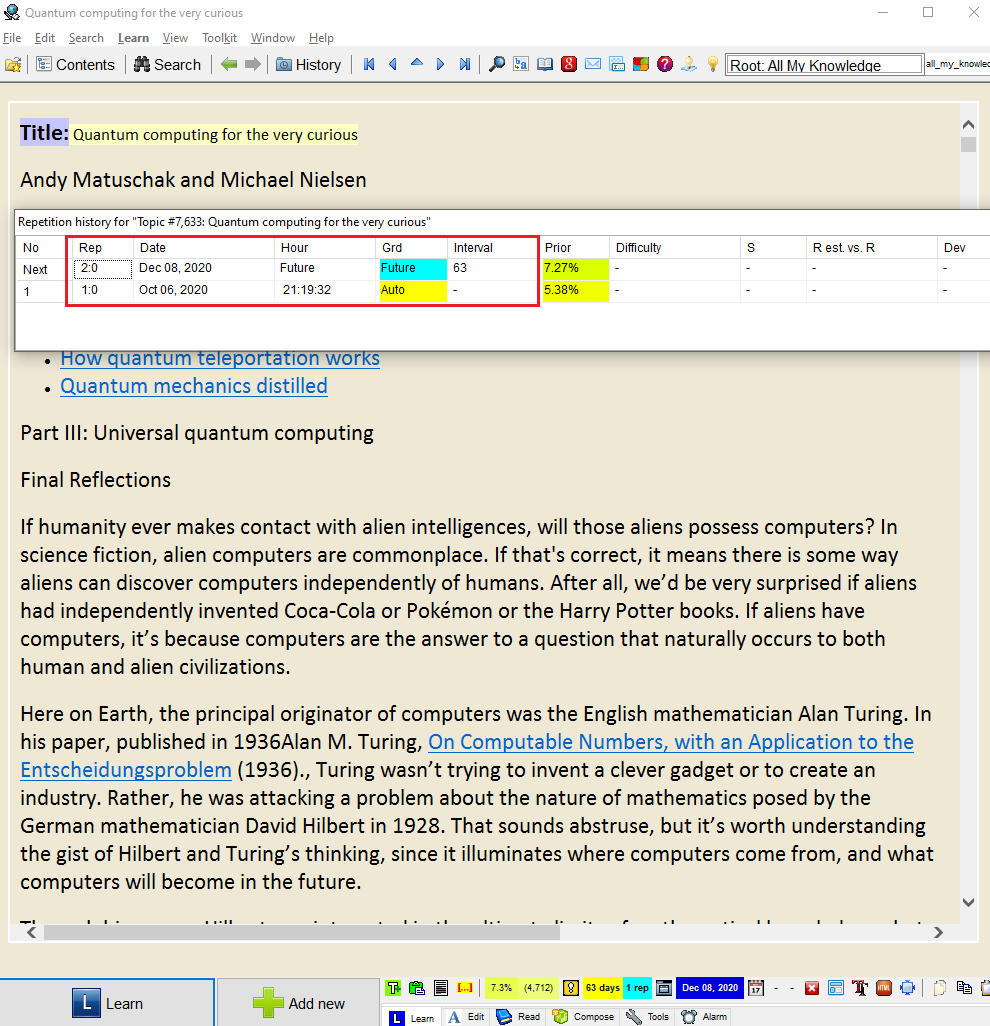
I imported this article into SuperMemo on Oct 06, 2020. Then I’d completely forgotten about it. Why? Because as much as learning about quantum computing is interesting, it’s not important for me to be reading it now. Say if I were a philosophy major, reading Nicomachean Ethics by Aristotle in SuperMemo will obviously take precedence over this article. Giving it a cool-down period (by not reading what’s imported immediately) helps alleviate the priority bias. All old articles were once new. If I spend all my time reading new articles, old ones will never get my time.
Look at the picture again. The algorithm had decided that it’d show it to me on Dec 08, 2020. That’s 63 days after importing. Let me fast forward to Dec 08, 2020. When I open SuperMemo, I’ll do my normal flashcard reviews. Then suddenly BAM! “Quantum computing for the very curious” will show up (because it’s in the outstanding queue for that day). Let’s say if I’m not in the mood to be learning about quantum computing, I’ll hit “Next” and SuperMemo will postpone it again (depending on the priority set; it’ll probably be longer than 63 days).
2. Initial read
Let’s say I’m interested in this topic, so I read it immediately when it showed up. During my initial processing, I’d split the article according to the table of contents.
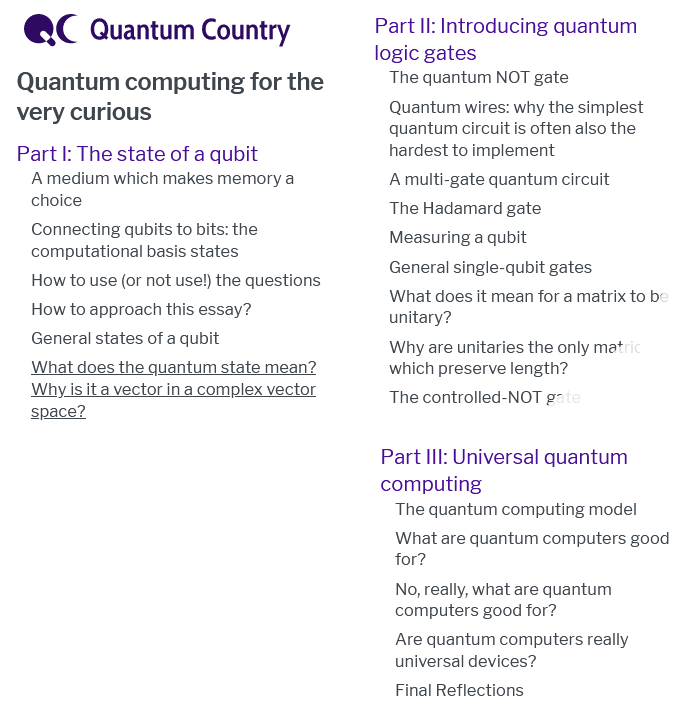
This is how my Knowledge Tree would look like:
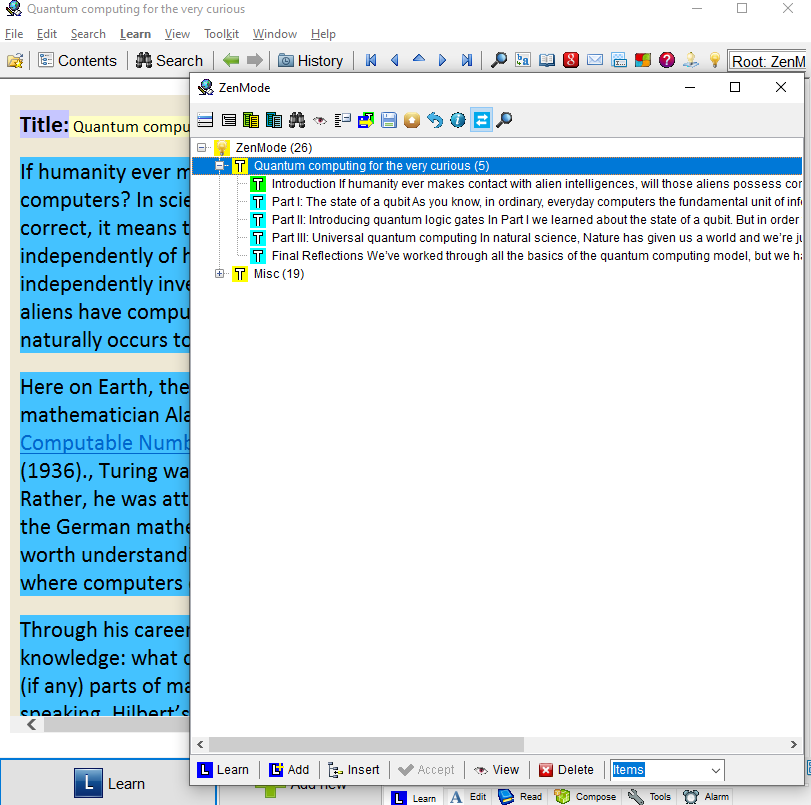
The green T icon means that this Topic is in the outstanding queue. The blue T icon means that those Topics won’t show up in the outstanding queue (they’re in the pending queue). It doesn’t make sense to be reading part III when I’ve not even finished the introduction. The reading order of this whole article has to be sequential.
Then I’d read from the first Topic:
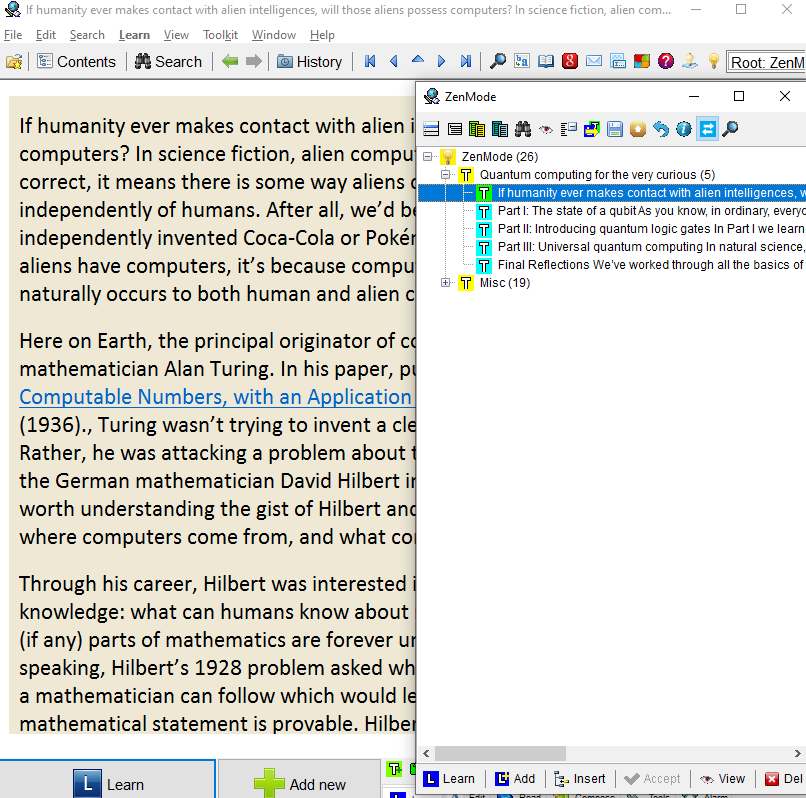
Then I’d make this first extract:
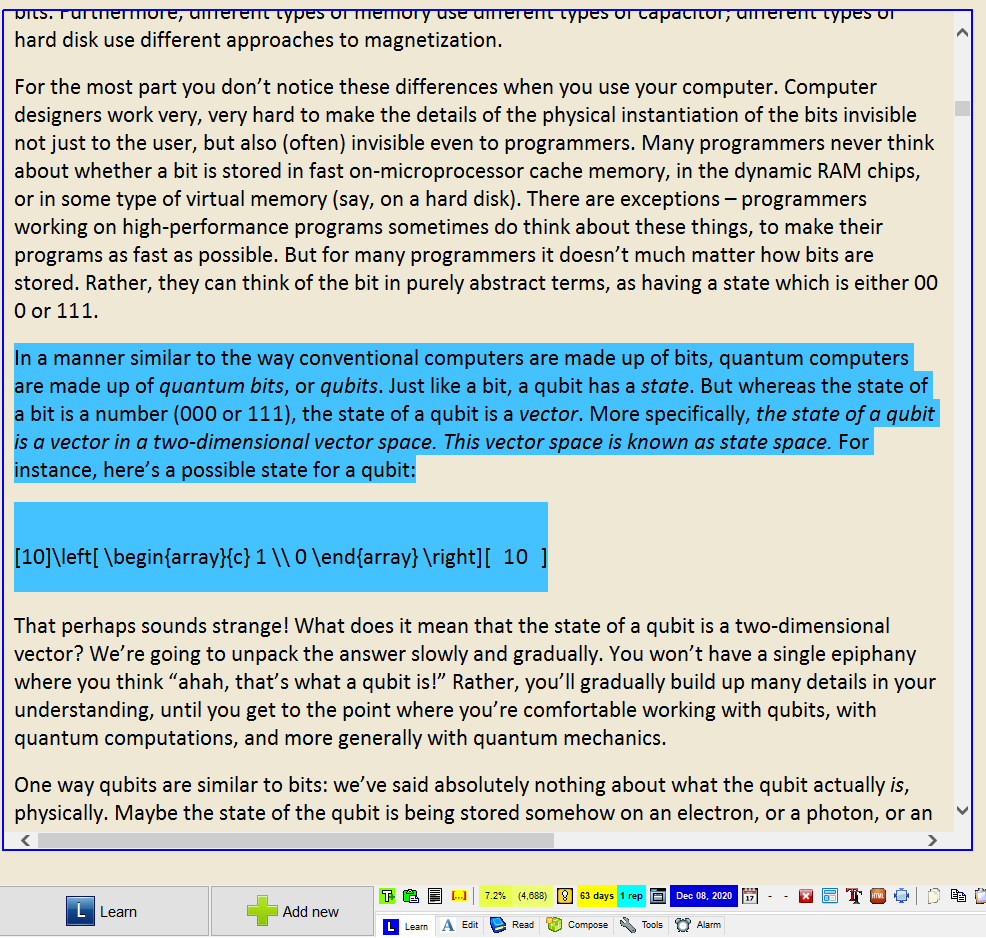
The blue part means that when reading, I found it important, so I’d extracted it (hence the color blue). Every extracted Topic becomes an independent sub-Topic with its own review schedule. I might see this sub-Topic tomorrow, a few days or weeks later. This is determined by the algorithm (unless manually intervened).
I’d go on to do the same: extracting as I read along. Then I’ll have this:
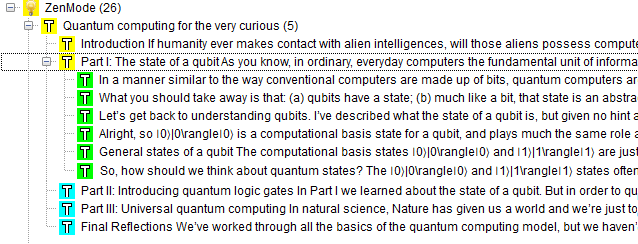
What to do with these sub-Topics?
After reading part I in one setting, I’d call it a day for this article. Since all the sub-Topics have their own review schedule, they’ll show up in the outstanding queue in the future. I can then process them further. It might take a week or a month. Regardless, after processing all the sub-Topics from part I, I’d get this:
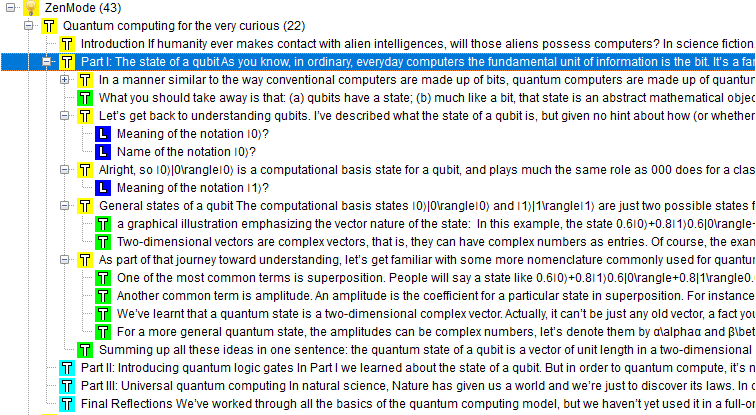
Understanding the Knowledge Tree
The first green T “What you should take away…” means that I have yet to decide what to do with it. It’ll continue showing up in the outstanding queue. I’ll decide its fate in the future: maybe my future self doesn’t find it important and would dismiss it, or postpone it again. This depends on my future prior knowledge and my perceived significance of it.
Those yellow T icons mean that I’ve done processing them (dismissed) and they won’t show up in the outstanding queue (hence I won’t have to read them again.)
Look at the second yellow T “Let’s get back to understanding qubits…” There are two blue L. They are Items. Items are just normal flashcards, i.e., important parts worth further committing to memory. I’ll need to do active recall on them ad infinitum:
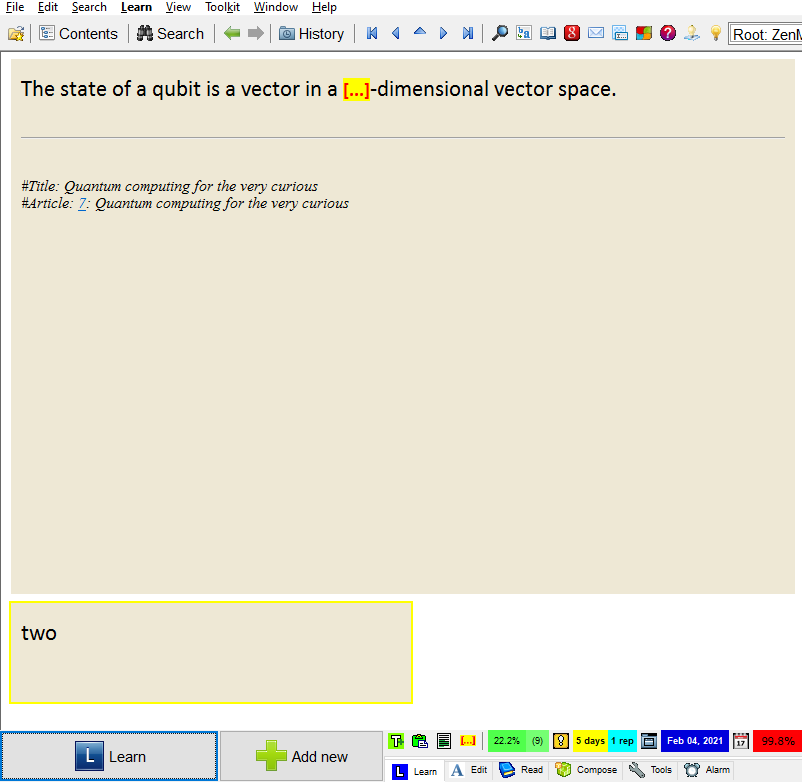
Look at the fourth yellow T “General states of a qubit…” There are two green T. It means that I’ve further extracted some parts. Both of them will show up in the outstanding queue and then I’ll decide what to do with them. Reasons for extracting: for the first green T (a graphical illustration), I want to review it in the future; for the second T, I didn’t quite understand that part. I might fill in the knowledge gaps with reference articles and then get back to it later:
Finally, look at the last green T “Summing up all these ideas in one sentence…” During my initial read, I could barely understand it. This one sentence is dense and I couldn’t unpack the ideas. One litmus test is how much you can elaborate upon it. For the authors, they might be able to outline the whole article just from this small session. My understanding, on the other hand, was wishy-washy at best, non-existent at worst. Say a month later, when SuperMemo shows this sub-Topic to me, I’ll (ideally and hopefully) have a much better understanding on the Topic (with all the flashcard reps and sub-Topics review in between). When I review it again I might be able to connect a few pieces and hopefully, insights will emerge and understanding deepened.
Part I is processed
At this point I’m done with part I: I have a few parts for review in the future and a few flashcards for active recall. Then I’d introduce part II and continue this process:
Consider this piecing together a puzzle. One Item (flashcard) is one piece; a Topic (extracted article) is a three-piece. All of these Items and Topics combined to form the complete puzzle (big-picture understanding).
One more point: the Knowledge Tree has no impact on the review schedule. The review queue won’t go sequentially, i.e., from “What you should take away” to “Meaning of the notation |0>” and so on.
Flexibility in Incremental Reading
Your review sequence, time spent on a given Topic, number of sub-Topics and Items created, processing speed, will vary greatly. This flexibility can be a source of confusion when trying to understand IR. The following is my take on them:
Review sequence
Topics are interleaved. Again, every sub-Topic (green T icon you see under part I) has its own review schedule. Their review schedules are not necessarily sequential (in order), however. This means that I might review “Let’s get back to understanding qubits” (third T) before “In a manner similar…” (first T). I don’t know how the algorithm determines the order, but I think potential answers can be found in Algorithm SM-17.
Does the order matter? It might, but at this point, when I review either Topic, I’d have read it once. It’s not completely new to me. My initial read should have given me enough background information to make it, more or less, self-contained, i.e., independent on other parts. Regardless, if I were lost, I can always, on the fly, go one sub-Topic up to its sibling or even parent for more background information (context).
At the early stage, my understanding and connections among these Topics are likely to be fuzzy (or even non-existent), but at this point, it’s not necessary to dive into the nitty-gritty. That will come later:
Topics and Items are also interleaved. The review of Topics (and subsequent sub-Topics) and Items are interleaved (mixed). During the review, I might re-read a sub-Topic before doing a flashcard repetition. A sub-Topic makes you focus on one specific concept or idea. If you don’t have enough prior knowledge for a sub-Topic, you can delegate dealing with it, by either postponing or read a reference article first:
All written materials, depending on the reader’s knowledge, pose a degree of difficulty in accurately interpreting their meaning. This is particularly visible in highly specialist scientific papers that use a sophisticated symbol-rich language. A symbol-rich language is a language that gains conciseness by the use of highly specialist vocabulary and notational conventions. For an average reader, symbol-rich language may exponentially raise the bar of lexical competence (i.e. knowledge of vocabulary required to gain understanding).
Incremental reading makes it possible to delay the processing of those articles, paragraphs or sentences that require prior knowledge of concepts that are not known at the moment of reading. The processing of the learning material will only take place then when the new information begins to slot in comfortably in the fabric of the reader’s knowledge. You can then gradually proceed through this material and gradually build the understanding from basic or simple facts towards details or more complex components of knowledge. - Advantages of incremental reading
Time spent
For the same amount of time, you may spend 1 hour reading part I, or you can spend 20 min today, and then 40 min tomorrow to finish part I. This whole process, i.e., from your initial read to done processing, might span across a whole day, a week, or even a month. It depends on your priority and how much you want to read it.
Number of sub-Topics and Items created
Your Knowledge Tree for part I will be very different from mine. Factors such as prior knowledge and priority set (how important this article is to you) will affect your depth and width of processing. Simply, I’d create many more flashcards if this article was to be tested in the exam.
Processing speed
How fast you process this mini-book depends on your priority and prior knowledge. It can happen in a matter of days, weeks, or even years. If you were a Computer Science or Physics major, then you might be determined to finish the whole article in a week. If you’re really just “the very curious” type, then you may finish it in a year. Also, if you were familiar with quantum computing, you certainly will require fewer reference articles and thus, can read it at a faster pace. For me, I know literally zero about the subject at hand, so I have no prior knowledge to build upon. I’ll need a lot more time to digest and build the foundation necessary to understand the content as I read along.
Also, there is not really “finishing an article” in SuperMemo. For one thing, you have to keep reviewing the Items produced from the original article, even if it’s 30 years apart. Then the next review schedule of a sub-Topic might be 2 years later (Incremental Reading: Reading the Same Article Two Years Later). Then, if you’re fuzzy about a particular part, you might need to go back and review that sub-Topic.
Manual intervention
You decide how much you let the algorithm handle your review schedule. For example, you may intentionally read all the parts in one setting without making any flashcards. You may already make flashcards during your initial read, but you may also make your first flashcard only when you see a sub-Topic a week later. Or you may never make any flashcards for a given article. It’s completely up to you.
For example, for an exam, it doesn’t make sense to review a sub-Topic two months later when the exam is a week later. I would manually decide the review schedule. That’s what I did for my Korean history class. A few days before the exam, I did IR for the assigned book chapters. I made some flashcards and exported them to Anki. I crammed as much as I could and regurgitated at the exam.
Conclusion
I believe this is how one should “read”: actively processing the content to make the most out of it. You can see this is drastically different from traditional linear reading, i.e., cover to cover and in long sessions.
Here’s the best video to get you started on IR: Starting with SM Going through the IR Manual. Not enough? Incremental reading+commentary|@Naess and Incremental Learning 1.30 h in 10 minutes-Fowl (COMMENTED!).
If you want to learn more about IR, here are some articles from the creator of SuperMemo, Piotr Wozniak himself: Advantages of incremental reading, Inevitability of incremental reading, Why is incremental reading not popular?
If not, you may read my other articles on IR: The Significance of Incremental Reading in SuperMemo: Part I, Part II, Demonstration: My Workflow of Incremental Reading, SuperMemo’s Incremental Reading: Explained.
In the second part, I’ll compare this “Quantum computing” mnemonic medium with SuperMemo’s IR.